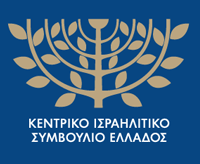 In ancient Jewish history, Athens occupies a secondary position, compared to the importance of the cities of Alexandria, Antioch, Rome, Cyrene or other lesser known cities of Asia Minor. Nevertheless, the indications for the existence of relations between Athens and Palestine date back to 6ο century BC A large number of pottery sherds, discovered in various areas of Palestine during the Persian period, prove the economic influence of Athens. Coins, dating from the Persian period of Palestine, bear on one side the inscription "Yahud" and on the other the depiction of an owl, similar to the Attic drachma.
In ancient Jewish history, Athens occupies a secondary position, compared to the importance of the cities of Alexandria, Antioch, Rome, Cyrene or other lesser known cities of Asia Minor. Nevertheless, the indications for the existence of relations between Athens and Palestine date back to 6ο century BC A large number of pottery sherds, discovered in various areas of Palestine during the Persian period, prove the economic influence of Athens. Coins, dating from the Persian period of Palestine, bear on one side the inscription "Yahud" and on the other the depiction of an owl, similar to the Attic drachma.
After the conquest of Palestine by Alexander the Great there was, apparently, an increase in the activities of the Athenians in the occupied country. The presence of an Athenian in Palestine is evidenced by a contract for the purchase of a slave girl from Transjordan, dated 259 BC. Among the signatures of the witnesses to the contract appears the name of "Heraclius, son of Philip, of Athens", (Tchericover, Corpus 1 (1975), 119-20 ), who was in the service of Apollonius, treasurer of Ptolemy II. An Athenian was at the head of the army of Antiochus the Great, sent to Palestine to enforce his religious policy (6 Maccabees, 1:XNUMX).
With the establishment of the Hasmonean state, Athens was one of the cities that entered into relations with the new state. Josephus mentions (Arch. 14:149) a decision, taken by the people of Athens in honor of the High Priest Hyrcanus, ethnic leader of the Jews. In the decision it is emphasized that Hyrkanos always maintained friendly relations with the Athenians and always received them cordially when they visited him.
Therefore it was decided to award him a gold medal, to place a bronze statue of him in the church of the Municipality and to express the pleasure of the city. The Historian Josephus associates this work with Hyrcanos II, but most of the contemporary scientists maintain that the work concerns Hyrcanos I and determine it in the year 106|5 BC. (the year in which Agathoklis was ruler of Athens). Also, Herod continued the tradition of good friendship with Athens (Josephus, Pol.1:425). Various elements have been preserved, which confirm the existence of friendly relations between the Athenians and the house of Herod.
Specific evidence for the existence of a Jewish community in Athens exists only from the beginning of the first century AD. Agrippa I in his letter to Gaius Calligula mentions Attica as one of the regions inhabited by Jews (Philon, Legat.281). Paul also visited a synagogue in Athens and met there, besides Jews, several Gentiles who honored the Jewish religion (Acts, 17:17). "Therefore he was chosen in the Synagogue after the Jews and after the God-fearing and in the market place every day after those who came". Various inscriptions testify that Samaritans lived in Athens (IG, ed. Minor. Nol. 2-3, part 3|2, now. 10219-92), as well as Jews (no. 12609), including a Jerusalemite (no. 8934).
In Judeo-Hellenistic literature, special attention is paid to Athens, the most famous city of Greek civilization. Philo refers to Athens with deep respect, following the pattern of ancient Greek writers (see prob.140), and mentions famous figures in the history of Athens, such as Solon (Spe. 3:22), as well as historical events, relating to Athens, including the dispute between the Athenians and the Lacedaemonians, (Mos. 2:19). Josephus often refers to Athens and its customs, especially in the romance of "Kat'Apion".
Athens also occupies an important position in Talmudic-Midrasic literature. The Midrash on the book "Lamentations" contains innumerable stories - legends, which are intended to compare the worth of the Jews of Jerusalem and the Athenians. Many of these stories begin with the phrase: "An Athenian came to Jerusalem." The Babylonian Talmud records the story of Rabbi Joshua ben Hananiah, who at the urging of the Roman emperor came to Athens and held a dialogue with the city's elders.
After the conquest of Athens by the Turks (1456), Mohammed II the conqueror granted the inhabitants the right to prohibit the settlement of Jews there. Nevertheless, a number of refugees from Spain and their descendants found asylum in Athens after 1492. In 1705 a French traveler met 15 – 20 Jewish families in Athens.
The Israelite Community of Athens was among those communities that were destroyed during the Greek Revolution against the Ottoman Empire (1821 – 1829). After 1834, however, and the proclamation of Athens as the capital of independent Greece, a small Jewish community developed. A number of Jewish families from Germany came and settled in Athens. Among them was the stockbroker Max de Rothschild, who participated in King Otto's entourage. Through the Duchess of Placentia, a large area was acquired for the construction of the Synagogue (1843). The Duchess settled in Athens in 1831 and developed through Bible study a deep sympathy for Judaism. In 1847, the Greek authorities forbade the public procession of the statue of Judas Iscariot, so as not to offend Baron de Rothschild, who was then in Athens. In retaliation, a part of the crowd burned the residence of the Israelite David Pacifico, a British citizen and honorary consul of Portugal. The British government demanded the payment of compensation and, finally, the Foreign Secretary Lord Palmerston blockaded the port of Piraeus in 1850 with English ships. In 1852 the municipal authority renounced the donation of the Duchess of Placentia for the construction of a Synagogue.
The Jewish presence increased from 60 people in 1877 to 250 in 1878. The Jewish Community was officially recognized in 1889. In 1890 the president of the Community was Charles Rothschild (1843 – 1918). At that time, there were 3 small synagogues in operation.
With the improvement of the economic settlement after the Balkan wars (1912 – 1913), a number of Jews from various regions of Greece – especially Thessaloniki – and Asia Minor settled in Athens. The immigration of Jews to Athens increased with the great fire of Thessaloniki in 1917. On the eve of World War II, the Jews of Athens numbered approximately 3.000. The most affluent Jews were Ashkenazim, while the Sephardim who came from various regions of Greece and Turkey were mainly itinerant sellers, second-hand dealers and small shopkeepers.
GERMAN OCCUPATION - THE PERSECUTION OF THE JEWS OF ATHENS
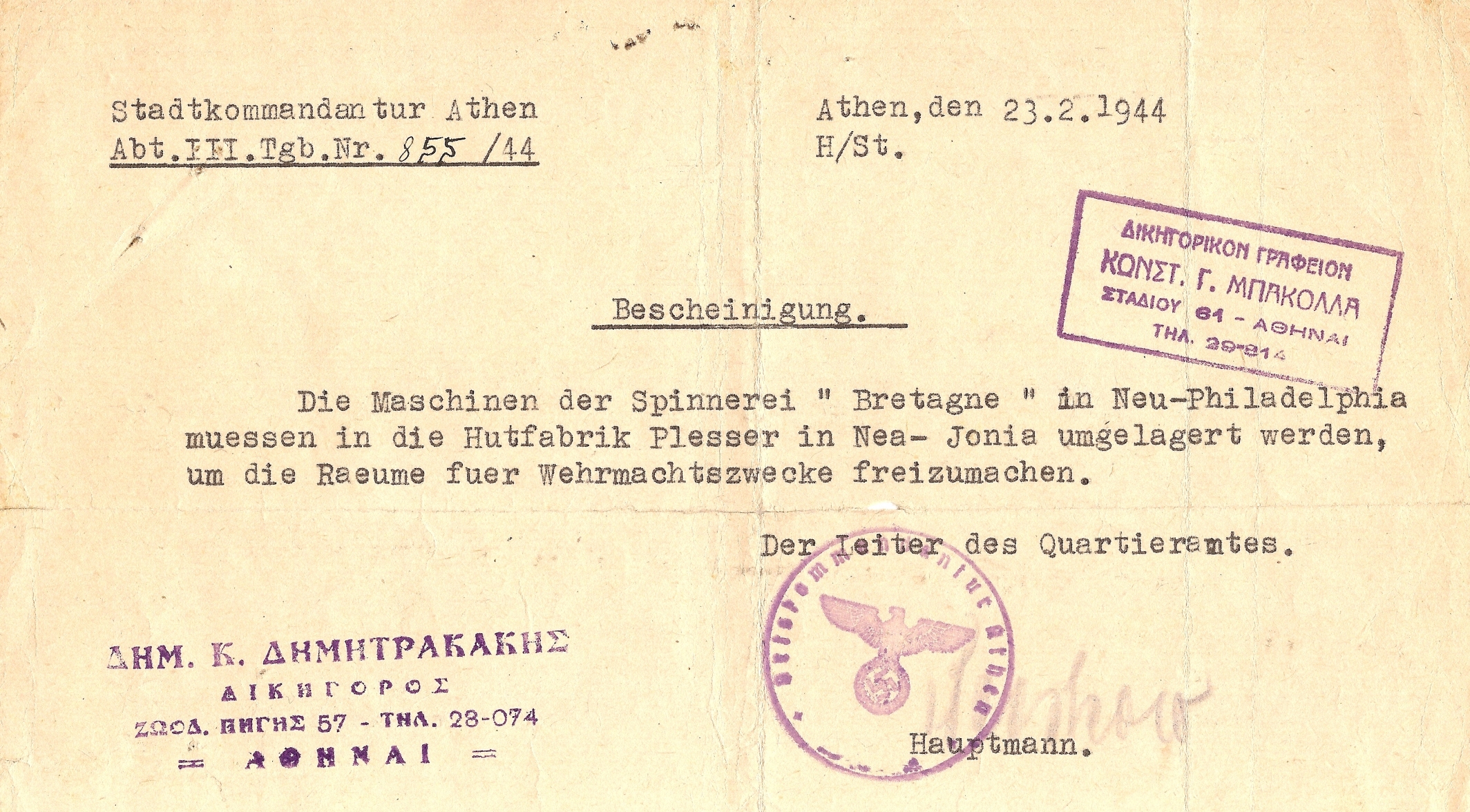 On April 27, 1941, as soon as the Germans entered Athens, they claimed from their Italian allies the monopoly of Jewish affairs. Despite the Italian reaction, "satrapic right" and with complete contempt for the Italians, they immediately took over the Jewish affairs.
On April 27, 1941, as soon as the Germans entered Athens, they claimed from their Italian allies the monopoly of Jewish affairs. Despite the Italian reaction, "satrapic right" and with complete contempt for the Italians, they immediately took over the Jewish affairs.
Thus, in May 1941, the Nazis confiscated the archives of the Israelite Community. They confiscated the rich rabbinical library and arrested the main members of the Community Council. In accordance with their well-known tactics, the Nazis recruited into the service of the SS some Jewish émigrés from Central Europe who fled to Athens. These persons surrounded them with their favor and protection, in order to turn them against their Athenian co-religionists. The Chief Rabbi, Elias Barzilai, in consultation with Asser Moses and the other leaders, treated them with a spirit of tolerance. They didn't want to irritate the Nazis, but they had their plan.
the 1η September 1941, the Italians appointed, with their official announcement, Rabbi Barzilai president of the Community. The earlier order of his appointment by the Nazis was completely ignored. The opposition between the two allies over Jewish issues, aptly incited by Barzilai, erupted into open conflict. The Italian authorities took specific measures to protect the persecuted Jews. In response, the Nazis increased the pressure. On July 14, 1942, they incited ESPO, a Greek "National Socialist" organization, to attack the Community. Members of the organization broke into its offices, ransacked and vandalized them. The Italians, alerted, arrested the rioters, but, under pressure from the Germans, were forced to release them. However, on September 20, the building where the ESPO was housed was burned down by an incendiary bomb thrown by members of the Resistance. The Germans blamed the Jews for this attack and forced the Italians to arrest the leadership of the Community. However, since the interrogations did not result in anything against them, they were released after twenty days.
As the Nazis tightened the reins, the Jews became more organized. Solidarity and care teams for the refugees from Thessaloniki were established, as well as sysistia. The Italian authorities showed more active interest. But the Greek ones didn't back down either: the Gendarmerie and the City Police, under the direction of Angelos Evert, were ordered to issue false identity cards to those Jews who wanted it. These IDs, which had Christian names and listed Christian Orthodox as their religion, were indistinguishable from the "real" ones, since they had been issued by the police authorities themselves, and therefore could pass any German control.
At the same time, Archbishop Damascenes made sure, together with the Director of the Registry of the Municipality of Athens, P. Chaldezos, that a special file was opened, where the Jews who were baptized Christians in order to be saved were registered. In this way and with the help of their compatriots, 560 Athenian Jews, as well as others from various cities, who had earlier found refuge in the capital, survived until the end of the war pretending to be Orthodox Christians.
The Orthodox Church also took an active stance in favor of the Jews, under the enlightened guidance of the Archbishop of Athens and all Greece, Damascene. With his secret encyclical to all the churches, he urged the priests and Christians to give every help to the persecuted Jews. The sacrifices Christians made, hiding and hosting Jewish families, are touching. The priests celebrated mixed marriages, without bothering about the types of catechism and baptism. Thus, several Jews decided to be baptized and became Orthodox or Catholic.
The Archbishop's actions culminated in the two famous Memoranda: The first, dated March 23, 1943, to the Prime Minister of the Greek Occupation Government, Con. Logothetopoulos, asked him to intercede with the German Authorities, in the name of the Greek people, so that the persecution of the Greek Jews would stop. In his memorandum he defended the Jewish presence in Greek social life, emphasizing how perfectly the Jews had assimilated. It also reminded him of the article of the 1941 Treaty of the Surrender of Greece, which stated that "The occupying authorities undertake to protect the honor and property of all Greek nationals", which did not make any distinction. (The full text of the Memorandum is published on another page of this issue.)
The second memorandum, dated 24 March 1943, and of similar content was sent directly to the Plenipotentiary of the Third Reich for Greece, Altenburg. Both memoranda were co-signed by many important figures of Greek public life, which, with the conditions of terror imposed by the SS, certainly required a lot of courage.
On September 8, 1943, the capitulation of Italy became known. The Italian Troops of Occupation, who followed Badolio, were captured by the Germans. The Jews of Athens and the provinces lost a valuable support. The Nazis, despite the spies and treacherous elements they used, saw that the Jews of Athens were not easy prey. They could not be arrested in one night, because they were hidden in different places. That is why they launched an insidious propaganda. Their propaganda was intended to discourage the Jews. But they did not achieve this. The Nazis, seeing their failure, transferred on August 10 from Thessaloniki, Visliceny, with the order to arrest and send to Auschwitz all the Jews of Athens and the provinces that were under Italian Occupation until then.
On September 21, Chief Rabbi Barzilai was summoned to appear before Visliceny. The invitation was regarded by the Jews as the commencement of hostilities. Community members were alerted to be on alert. The Rabbi came undaunted to the appointment. Visliceny ordered him to provide, within 24 hours, a detailed list of the Jews, including the fugitives of Thessaloniki. A Community Assembly was immediately called and it was decided to buy time at all costs. So the next day, the Rabbi excused himself to Visliceny that the Community's records had been destroyed by the ESPO and that he had not been able to compile the list. This statement by Barzilai made Visliceny mad, who was finally forced to give an extension of another 48 hours. During this time, all Jews were notified to hurry and disappear. A crew of Community officials rushed out at night, under the direction of the Rabbi, and burned all the records, all documents and all the books of the Community. In the same night, all the leaders of the Jews also disappeared. Barzilai fled to a friend's house in Kolonaki. The lawyer Ilias Kefalidis, a liaison of the Resistance, mediated for the Rabbi's escape to the mountain. By September 25, most of the Jews of Athens had already disappeared.
Seeing after two or three days that Barzilai did not return, Vislicheni began to suspect that the Rabbi had tricked him. Going to the offices of the Community and finding everything locked, he furiously ordered the door broken down. From the disorder and the burnt papers he immediately understood what had happened. Enraged, the executioner returned to his office and dictated to General Stroop an order calling on all Jews to return quickly to their permanent homes. He ordered them a period of five days to present themselves at the offices of the Community and be recorded in the registers, stating their addresses. He threatened those who did not conform with rifles, while he established a new Community Council, the "Council of Elders". He drew the attention of the Greek police authorities to the exact execution of the order, predicting severe penalties for the Athenians who might dare to hide Jews or facilitate their escape
Unfortunately, approximately 1.200 Jews were found in Athens who complied with Stroop's order. Bloodthirsty Vysliceny watched the attendance of anxious Jews, who came hesitantly and fearfully to be registered in the registers. Poverty and desperation made these sad people unable to hide continuously. They came with some hope, since they were promised help and finding work. Thus, a month after the establishment of the new "Council of Elders", about 2.000 Jews were registered. When the record stopped at 2.000, Visliceny realized that the great mass of Jews had escaped him. He wanted, however, to add to his trophies by capturing and exterminating even 2.000. However, he was opposed by the German ambassador at the time, who considered that his methods were outdated. This great executioner had to leave the scene. A new tactic was needed to attract as many Jews as possible. He was replaced by Booger, who undertook to carry out Himmler's extermination plans. With the help of whistleblowers, about 200 additional Jews were brought out of hiding and handed over to the Gestapo.
The fateful day was Friday, March 23, 1944: The Gestapo, with a surprise block in the Synagogue of Athens, arrested all those present, about 350 people, mostly men. At the same time, German trucks grabbed the women and children from their homes and took them to the Synagogue. About 800 people gathered in this way. No distinction was made between foreign nationals. The Spanish ambassador protested in vain. They coldly replied that the arrests were made on orders from Berlin. The 800 prisoners were left without food and water in the Synagogue until dusk on Saturday. Then closed trucks came, and they were taken to Haidari, where they mingled with the other Jews who had been caught earlier. There the unfortunate captives suffered the usual beatings, humiliations and abuses.
On Sunday, April 2, the Jewish prisoners, including foreign nationals, were transported in closed cars to Ruf station. Meanwhile the Nazis had arrested 1.200 Jews from Preveza, Arta, Agrinio and Patras. They had also lured them to Haidari, so as not to miss the opportunity to include them in the same mission. The International Red Cross, which rushed to give them some help, was brutally blocked by the enraged Nazis.
The train was formed by 30 wagons. It started at 1 p.m. for Poland. In Larissa the harvest became richer. Another 2.400 prisoners were added, who had been caught in Volos, Trikala and, above all, Ioannina. When the serpentine train of the dying passed through the Thessaloniki station, it contained 5.200 people, crammed into 84 carriages. He followed his gruesome journey and arrived at Auschwitz station on April 10. There was the place of Geeni: The suffocating gas chambers, the crematoria with the ovens of the burning corpses.
Only a small number of Jews with Spanish citizenship were fortunate enough to be transferred to the Bergen-Belsen "transit" camp and released from there to Spain, after endless negotiations between the German and Spanish governments.
After the end of the war and the return of the survivors, Athens came to have a larger number of Jews than before the war, since many survivors from the destroyed Jewish communities of the province had no choice but to flock to Athens, to live near their co-religionists.
POST-WAR
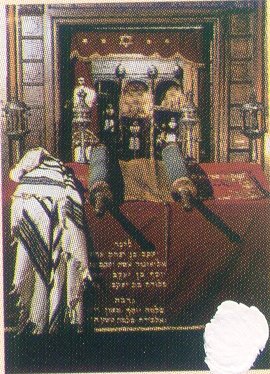
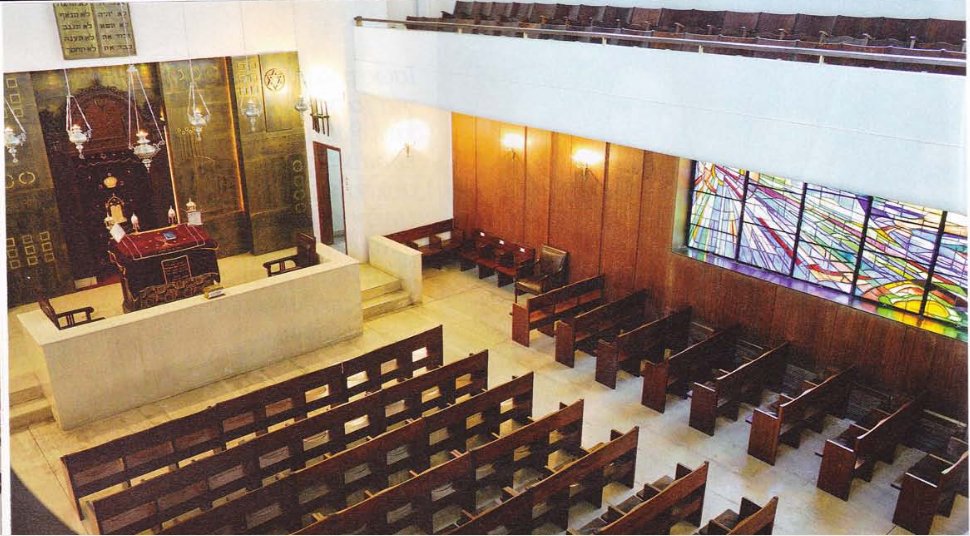 After the liberation, the Jewish Community of Athens was re-established and its population increased. Those who survived the concentration camps, as well as members of other communities settled in Athens. The Community of Athens reached 5.000 people during the same period. A little later, however, due to immigration, the population decreased to 3.000 people. The Community began to function again. They face a variety of problems, such as financial for the reopening and psychological for those people who returned from the camps. At first there was even a feeding problem. "Joid" effectively offered her help at this stage. While a clinic was also created to provide all medical assistance. ORT training centers and hostels for girls who had lost their families were also established. All Jewish institutions were founded from the beginning in an effort to resurrect the Jewish life of Greece.
After the liberation, the Jewish Community of Athens was re-established and its population increased. Those who survived the concentration camps, as well as members of other communities settled in Athens. The Community of Athens reached 5.000 people during the same period. A little later, however, due to immigration, the population decreased to 3.000 people. The Community began to function again. They face a variety of problems, such as financial for the reopening and psychological for those people who returned from the camps. At first there was even a feeding problem. "Joid" effectively offered her help at this stage. While a clinic was also created to provide all medical assistance. ORT training centers and hostels for girls who had lost their families were also established. All Jewish institutions were founded from the beginning in an effort to resurrect the Jewish life of Greece.
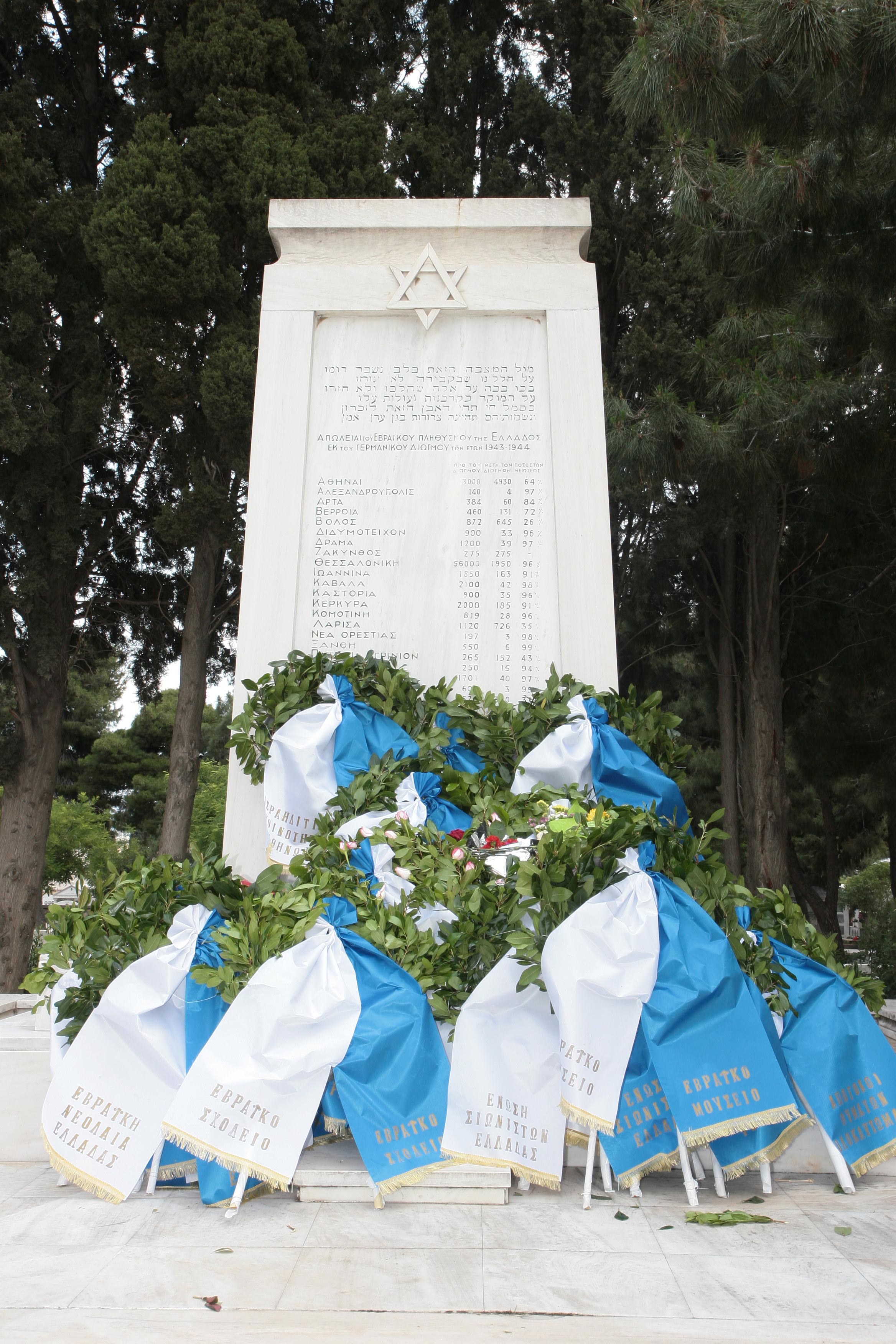
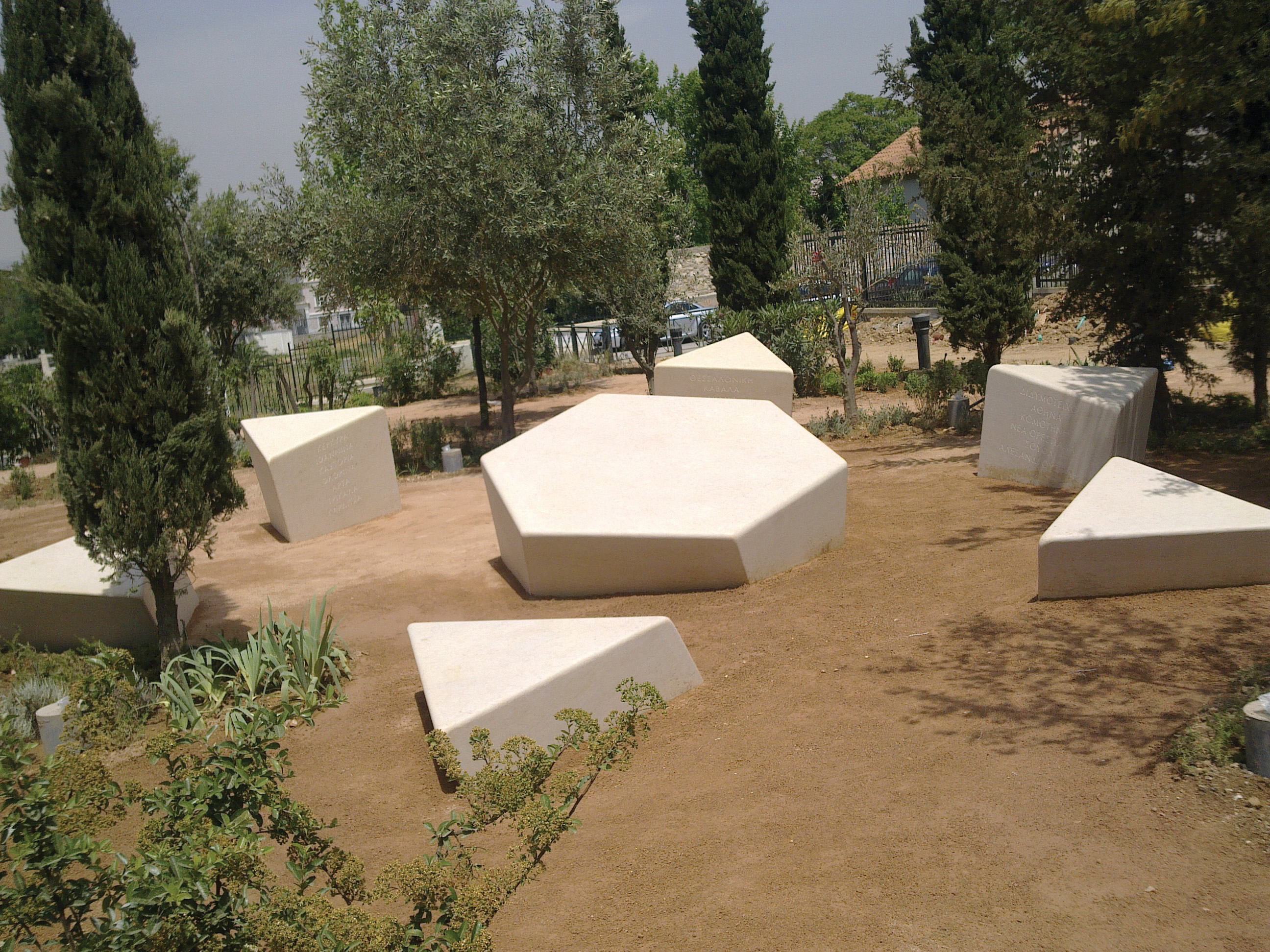
Today, 2.500 Jews live in Athens, making up the country's largest Israeli community. In Athens, there are two Synagogues, a Jewish Primary School, a Spiritual Center and a Jewish cemetery. In May 2010, a Holocaust Memorial was placed in Thisio, near the Synagogues.
In 2016, on the railings of the forecourt of the Beth Shalom Synagogue in Athens, the Monument to the Greek Righteous Among the Nations of Athens was placed. With this Memorial - which takes the form of a book with the names of the Greek Righteous engraved on its pages - Greek Jewry pays its due respect to the heroes of the Occupation, the Greek Christians who selflessly saved many of their Jewish compatriots, endangering their own their lives and that of their families.
 In ancient Jewish history, Athens occupies a secondary position, compared to the importance of the cities of Alexandria, Antioch, Rome, Cyrene or other lesser known cities of Asia Minor. Nevertheless, the indications for the existence of relations between Athens and Palestine date back to 6ο century BC A large number of pottery sherds, discovered in various areas of Palestine during the Persian period, prove the economic influence of Athens. Coins, dating from the Persian period of Palestine, bear on one side the inscription "Yahud" and on the other the depiction of an owl, similar to the Attic drachma.
In ancient Jewish history, Athens occupies a secondary position, compared to the importance of the cities of Alexandria, Antioch, Rome, Cyrene or other lesser known cities of Asia Minor. Nevertheless, the indications for the existence of relations between Athens and Palestine date back to 6ο century BC A large number of pottery sherds, discovered in various areas of Palestine during the Persian period, prove the economic influence of Athens. Coins, dating from the Persian period of Palestine, bear on one side the inscription "Yahud" and on the other the depiction of an owl, similar to the Attic drachma. On April 27, 1941, as soon as the Germans entered Athens, they claimed from their Italian allies the monopoly of Jewish affairs. Despite the Italian reaction, "satrapic right" and with complete contempt for the Italians, they immediately took over the Jewish affairs.
On April 27, 1941, as soon as the Germans entered Athens, they claimed from their Italian allies the monopoly of Jewish affairs. Despite the Italian reaction, "satrapic right" and with complete contempt for the Italians, they immediately took over the Jewish affairs.
 After the liberation, the Jewish Community of Athens was re-established and its population increased. Those who survived the concentration camps, as well as members of other communities settled in Athens. The Community of Athens reached 5.000 people during the same period. A little later, however, due to immigration, the population decreased to 3.000 people. The Community began to function again. They face a variety of problems, such as financial for the reopening and psychological for those people who returned from the camps. At first there was even a feeding problem. "Joid" effectively offered her help at this stage. While a clinic was also created to provide all medical assistance. ORT training centers and hostels for girls who had lost their families were also established. All Jewish institutions were founded from the beginning in an effort to resurrect the Jewish life of Greece.
After the liberation, the Jewish Community of Athens was re-established and its population increased. Those who survived the concentration camps, as well as members of other communities settled in Athens. The Community of Athens reached 5.000 people during the same period. A little later, however, due to immigration, the population decreased to 3.000 people. The Community began to function again. They face a variety of problems, such as financial for the reopening and psychological for those people who returned from the camps. At first there was even a feeding problem. "Joid" effectively offered her help at this stage. While a clinic was also created to provide all medical assistance. ORT training centers and hostels for girls who had lost their families were also established. All Jewish institutions were founded from the beginning in an effort to resurrect the Jewish life of Greece.

